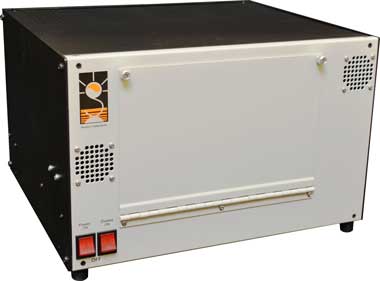I am interested in this product
Close Form

The Semi-Continuous OCEC instrument is a field deployable alternative to integrated filter collection with subsequent laboratory analysis. This instrument can provide time-resolved OCEC analyses on a semi- continuous basis with OCEC (organic and elemental carbon) results comparable to the recognized NIOSH Method 5040. A quartz filter punch is mounted in the instrument and samples are collected for the desired time period. Once the collection is complete, the oven is purged with helium, a stepped-temperature ramp increases the oven temperature to 850 °C, thermally desorbing organic compounds and pyrolysis products into a manganese dioxide (MnO2) oxidizing oven. As the carbon fragments flow through the MnO2 oven, they are quantitatively converted to CO2 gas. The CO2 is swept out of the oxidizing oven with the helium stream and measured directly by a self-contained non-dispersive infrared (NDIR) detector system. A second temperature ramp is then initiated in an oxidizing gas stream and any elemental carbon is oxidized off the filter and into the oxidizing oven and NDIR. The elemental carbon is then detected in the same manner as the organic carbon. Customers interested in ambient monitoring, site specific research, dynamometer studies, or any other work that would require continuous analysis would likely find this instrument best suited for them.
I am interested in this product
Close Form
Downloads
Detailed Specs
- Model 4G OCEC Instrument
- Latest Version of Operation & Calculation Software
- Parallel plate denuder
- Sampling pump
- 2.5 μm sharp cut cyclone
- Sample Inlet Installation Kit
- Controlling Laptop Computer w/ Windows 10 Professional, Operation and Calculation Software
- Performance Characteristics – real time, semi-continuous operation with typical time resolution from 30 minutes to 24 hours.
1. 8 LPM sample rate typical
2. Sample analysis time; 6 – 20 minutes depending on analysis method
3. Time resolution; depends on requirements, but 1 hour is typical for a single instrument application (80% or better sampling duty cycle)
4. Sensitivity and Detection Limit (LDL):
Range: TC – 0.2 to 600 ug/cm2
Range: OC – 0.2 to 600 ug/cm2
Range: EC – 0.2 to 30 ug/cm2
Range: BC (ie. Opt_EC) – 0.05 to 30 ug/cm2
Limit of Detection – 0.10 ug/cm2
Limit of Detection for BC – 0.05 ug/cm2
5. Measurement Range:
Range for 2 Hour Sample Cycle: OC – 0.2 to 100 ug/M3
Range for 2 Hour Sample Cycle: EC – 0.1 to 20 ug/M3
Range for 2 Hour Sample Cycle: BC – 0.06 to 34 ug/M3
Limit of Detection for 2 Hour Sample Cycle: OC – 0.2 ug/M3
Limit of Detection for 2 Hour Sample Cycle: EC – 0.1 ug/M3
Limit of Detection for 2 Hour Sample Cycle: BC – 0.06 ug/M3
- Measurement Method (User Configurable)
1. NIOSH 5040
2. EUSAAR2
3. Fast TOC with optical EC (BC)
4. IMPROVE-A temperature profile using TO/Transmission
5. User defined custom applications
- Calibration
-
-
- External Standard – Uses an external standard calibration gas. A fixed-loop volume of this gas in injected at the end of every analysis. All calculated results are referenced against this external standard.
- Primary calibrations are referenced against sucrose solutions or NIST traceable gas standards. NIST traceable gas standards are USER provided and must be ordered separately if desired.
-
- Support Gases to be supplied by customer:
He (99.999% or better) – Hydrocarbon and CO2 < 1 ppm
5% methane in Helium Balance – He (99.999%), Methane CP grade, certification to 2%.
10% Oxygen in Helium Balance – (99.999% or better for both gases)


